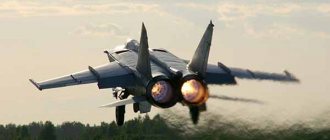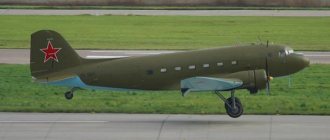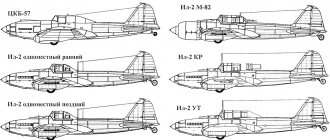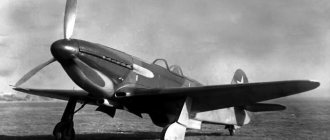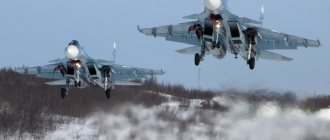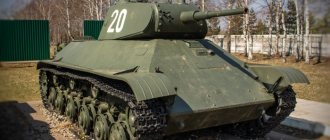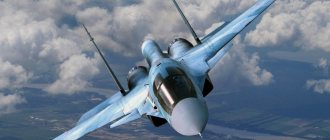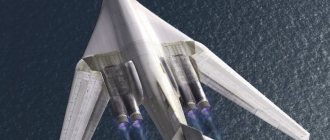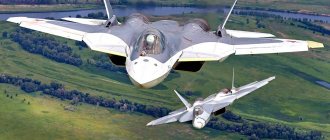The Su-25 is a Soviet/Russian armored subsonic attack aircraft, designed for direct support of ground forces over the battlefield day and night with direct visibility of the target, as well as the destruction of objects with given coordinates around the clock in any weather conditions. During testing in the DRA in the USSR Air Force, he received the nickname “Rook”.
Su-25 Grach in Syria - video
The Su-25 first flew on February 22, 1975. Aircraft of this type have been in operation since 1981, have taken part in many military conflicts and will remain in service with the Russian Air Force until at least 2022. On October 8, 2009, the Ministry of Defense of the Russian Federation announced the resumption of procurement of attack aircraft of this type for the Russian Air Force.
History of creation
Work on the creation of the Su-25 attack aircraft began at the Sukhoi Design Bureau in the mid-70s on an initiative basis, when it became clear that the decision made in 1956 to abolish attack aircraft and transfer its functions to fighter-bombers was erroneous. The chief designer in the group of creators of the Su-25 was the former commander of the T-34 tank, one of the most brilliant aircraft designers of the 20th century, Oleg Sergeevich Samoilovich (1926-1999)
During the development of the attack aircraft, research and development work was carried out on 40 topics, about 600 samples and mock-ups were manufactured and tested. In February 1975, the prototype of the attack aircraft, which had the working designation T-8, was lifted into the air, and in March 1981, the attack aircraft was adopted by the USSR Air Force under the designation Su-25.
From April to June 1980, two Su-25 vehicles were tested in combat conditions in Afghanistan (Operation Diamond). Under the cover of Su-17 aircraft, they attacked targets with high-explosive and concrete-piercing bombs, as well as NURS, making 3-4 sorties a day. A total of 100 test flights were carried out on two vehicles, including 44 combat ones.
From July 1981 to October 1982, Operation Exam was carried out in Afghanistan (sometimes the name “Rhomb-2” is found): in the 80th Sital-Chai assault regiment, at the end the 200th separate attack air squadron was formed (commander A.M. Afanasiev). Over the entire period, the squadron flew more than 2,000 combat missions; one aircraft was lost due to pilot error.
Prerequisites for the occurrence
Around the mid-60s, the military priorities of the USSR and the USA underwent dramatic changes. At that time, it became finally clear that the idea of crushing the enemy through nuclear weapons, cherished until then, was a senseless suicide on a planetary scale. Everyone agreed that the focus should be on the use of conventional weapons. Therefore, the military of both superpowers again paid close attention to the development of front-line aviation as the main strike force in all conflicts of recent years.
In those years, the USSR was armed with: MiG-19, MiG-21, Su-7B, and also the Yak-28. These machines were very good, but they were completely unsuitable for working directly on the battlefield. They had too high a flight speed, and therefore were physically unable to maneuver and hit small targets. In addition, the complete lack of armor put an end to their attack qualities: when attacking ground targets, any machine gun could pose a mortal danger to these aircraft. It was then that the prerequisites for the appearance of the SU-25 were laid. The technical characteristics of the new vehicle were to be somewhat similar to those of the legendary Il-2: armor, maneuverability, low flight speed and armament.
Su-25 modifications
Su-25 - Combat single-seat attack aircraft.
Su-25UB - Combat training two-seat attack aircraft.
Su-25K attack aircraft of the Czech Air Force
Su-25K - Commercial - export version of the Su-25. Between 1984 and 1989, 180 aircraft were built. The Su-25K was also called the ship version project.
Su-25T - anti-tank variant
Su-25T - An anti-tank attack aircraft created in 1984 on the basis of the Su-25UB. The central section was strengthened, radio-electronic equipment was placed in the gargrot in place of the second cabin, the nose was changed, the I-251 Shkval sighting system was added, an ILS was installed, the ability to use modern high-precision ammunition was added, the cabin was sealed.
Su-28
Su-28 - Training aircraft. Not mass produced.
Su-25UTG - two-seat sea-based aircraft
Su-25UTG - Training aircraft for learning to take off and land on the deck of aircraft carriers.
Su-39
Su-39 - Anti-tank attack aircraft, further development of the Su-25T. Equipped with a “Spear-25” radar station in a hanging container.
Su-25KM - Attack aircraft of the Georgian Air Force modernized by Israel. Avionics have been updated and the ability to use NATO ammunition has been added.
Su-25SM attack aircraft at the International Aerospace Salon MAKS-2011
Su-25SM - Update of serial Su-25. The avionics, AO and AV systems have been updated, ILS and MFI have been added.
Su-25UBM in Kubinka
Su-25UBM - A modernized two-seat attack aircraft, created as a combat training version of the Su-25SM and Su-39. The aircraft implements all the developments of previous modifications. The basis for the new aircraft was the two-seat Su-25UB. The radio-electronic equipment was replenished with the Bars-2 avionics complex, and it was also planned to supplement the Spear radar (there is no radar on the prototype). It is assumed that the aircraft can be used both as a training aircraft for single-seat modifications and as an independent combat unit. Moreover, in the latter case, the Su-25UBM will be able to conduct reconnaissance, guidance and coordination of the actions of its single-seat counterparts, turning into an air command post. The new aircraft made its first flight on December 6, 2008 in Kubinka, near Moscow. In 2011, the first stage of the State Survey was completed. For the first time, the aircraft will be equipped with a powerful radar and electronic warfare system, as well as air defense systems.
Su-25M1 - Ukrainian version of the modernization of the Su-25, which is carried out by the Zaporozhye Aircraft Repair Center. Modernized equipment from Ukrainian manufacturers was installed - satellite navigation, a new SHS system, a modernized radio station, and a modern sight counter. The analog sight has been replaced with a digital one. This allows you to increase your aiming accuracy by approximately 30%. The aircraft is now capable of using standard weapons against ground targets day and night, in poor visibility conditions and without leaving the clouds. The altitude of weapon use has been significantly increased, almost 3 times. An air parameters module and an on-board register of digital parameters of the BRCP are installed. The modernized single-seat Su-25M1 attack aircraft receive a new “digital” camouflage.
Su-25UBM1 - Ukrainian modernization of the Su-25UB similar to the Su-25M1.
Su-25SM2 - Upgrade option for serial attack aircraft.
Su-25SM3
Su-25SM3 - Updated single-seat attack aircraft. The GLONASS satellite navigation system (GPS) has been added with the ability to program the end point with an accuracy of up to ten meters, allowing the pilot to operate autonomously in “zero” visibility. It is equipped with the SVP-24-25 PNK (a variant of the SVP-24 “Hephaestus” for the Su-25), which makes it possible to increase the accuracy of unguided aircraft weapons to the level of guided weapons.
In service with the Russian Air Force
In the Russian Air Force, the following regiments are armed with Su-25 aircraft of all modifications:
- 368th assault aviation regiment - Budennovsk; - 960th assault aviation regiment - Primorsko-Akhtarsk; - Aviation group of the 3rd command - Chernigovka; — 266th assault aviation regiment — Steppe; - 279th separate fighter aviation regiment - Severomorsk-3; - 37th mixed aviation regiment - Gvardeyskoye airfield), Su-25SM squadron; - 4th Center for Combat Use and Retraining of Flight Personnel (Lipetsk) - attack squadron.
"Tank" version
The SU-25T aircraft was created somewhat differently. The history and characteristics of its weapons are directly related to the development of armored vehicles of that period. NATO made the final bet on heavy and well-protected tanks, and therefore required a special “subspecies” of attack aircraft that could carry out attack at even lower speeds, ensuring better target destruction.
This modification was adopted for service in 1993. The differences from the standard “Rook” are small, but they exist. General unification with the “parent” aircraft is 85%. The main difference is more advanced sighting equipment and the Vikhr anti-tank missile system. Unfortunately, during the collapse of the Union, out of 12 vehicles built, only 8 ended up in Russia. There was no further production or modernization of these aircraft. It’s sad, but the SU-25T, whose flight characteristics made it possible to confidently hit all Western tanks, no longer flies and is permanently parked in the Lipetsk center.
Combat use of the Su-25
Afghan war (1979-1989). In the spring of 1980, four Su-25s underwent combat evaluation in Afghanistan, showing complete superiority over their competitor the Yak-38. Since mid-1981, one Su-25 squadron took part in the Afghan war, which was expanded to an air regiment in 1984. The combat operations revealed the high survivability and maneuverability of the attack aircraft. Its relatively low flight speed allowed it to deliver very accurate strikes, something fighter-bombers lacked. In Afghanistan, the Su-25 received its nickname “Rook”, becoming the most famous aircraft of this war. After the Mujahideen acquired the Stinger MANPADS in 1987, the attack aircraft underwent modernization in order to increase survivability. One of the Rook pilots in Afghanistan was Alexander Rutskoi, the future vice-president of the Russian Federation. During his participation in hostilities, he was shot down twice - in April 1986 by fire from the ground and in August 1988 by a Pakistani F-16 fighter. The Su-25 showed high survivability in Afghanistan. On average, for every Su-25 shot down there was 80-90 combat damage; cases were described when aircraft returned to base with 150 holes. A number of sources talk about the loss of 23 Su-25 attack aircraft and 8 pilots in Afghanistan, while it is noted that there was not a single case of the loss of an aircraft due to the explosion of fuel tanks or the death of a pilot (although there is an assumption that the plane of Senior Lieutenant Shumikhin was lost as a result of the pilot being hit by fire from the ground). Researcher Viktor Markovsky considers these data incomplete and, citing documents from the 40th Army Air Force and the TurkVO Air Force Command Center, reports the loss of 33 attack aircraft and 12 pilots, indicating that in this assessment he did not take into account several aircraft written off due to combat and non-combat damage. In the books of Markovsky and Ildar Bedretdinov, as well as in some other sources, one can find a description of the circumstances of the loss of at least 34 attack aircraft in Afghanistan (including 24 in the air and 10 on the ground) and the names of 12 dead Su-25 pilots.
Iran-Iraq War (1980-1988). The attack aircraft entered service with the Iraqi Air Force in the second half of the 1980s. According to some sources, they were used very intensively in the war; according to others, they carried out literally several combat missions. Nothing is known about the effectiveness of their use and possible losses.
Gulf War (1991). Iraqi Su-25s did not fly combat missions during this war, but suffered combat losses. Seven planes flew to Iran, where they were included in the local air force, two more were shot down by American F-15 fighters during a flight attempt, and a number were destroyed by international coalition aircraft on the ground. In total, Iraq lost 31.
Civil war in Tajikistan (1992-1997). During the conflict, Su-25s of the Russian and Uzbek air forces operated.
Abkhazian war (1992-1993). Georgia used its Su-25s in the war. Several planes were shot down by Abkhazian air defense. There is at least one known case of the Russian Air Force Su-25 participating in the war.
Karabakh war (1991-1994). The Su-25 became the first combat aircraft to take part in the Karabakh war. In April 1992, Russian Air Force pilot of Azerbaijani origin Vagif Kurbanov stole his attack aircraft to Azerbaijan and flew combat missions on it until he was shot down. Later, Azerbaijan received several more aircraft. By the end of the war, the Armenian side also had its own Su-25s. In general, during the war, Azerbaijan lost 7 Su-25s, Armenia - 1.
First Chechen war (1994-1996). The Su-25 was the main combat aircraft used by the Russian Air Force in combat operations in Chechnya. At the very beginning of hostilities, attack aircraft of this type destroyed all Chechen aviation on the ground. The Su-25 operated most intensively in the winter and spring of 1995; subsequently, aviation was used sporadically due to the nature of the war after the June truce. The attack aircraft once again confirmed their high efficiency. Combat losses amounted to 5 aircraft (four shot down and one written off due to combat damage). Despite the high combat survivability of the Su-25, one of the attack aircraft was lost as a result of the death of the pilot from enemy fire from a DShK heavy machine gun - the bullets pierced the unarmored side glass of the cockpit canopy.
War in the Congo (1997-2002). 8 attack aircraft were purchased by the Democratic Republic of the Congo in 1999. Due to the lack of trained pilots in the national air force, all combat missions were carried out by hired pilots from Russia, Ukraine and Belarus.
Ethiopian-Eritrean conflict (1998-2000). Both sides had the Su-25 at the beginning of the third round of hostilities (May-June 2000). The use of X-25 and X-29 guided missiles by Ethiopian attack aircraft was noted.
Second Chechen War (1999-2000). As in the first war, Su-25s were actively used to provide close air support to ground units of the federal forces and made “free hunting” missions. The intensity of aviation operations decreased sharply after the end of the main phase of hostilities in the spring of 2000. By mid-2001, 6 attack aircraft were lost.
Conflict in Macedonia (2001). Directly during the hostilities, the Macedonian Air Force received several Su-25s from Ukraine and used them to attack the positions of Albanian militants.
French-Ivoirian conflict (2004). On the afternoon of November 6, a Su-25 aircraft belonging to the Ivorian Air Force attacked the positions of the French peacekeeping contingent, as a result of which 9 peacekeepers were killed and 31 were wounded. One American citizen also died. A few hours later, French aircraft carried out a retaliatory raid on Yamoussoukro airport and destroyed both of Côte d'Ivoire's Su-25s on the ground.
Armed conflict in South Ossetia (2008). Attack aircraft were actively used by the Russian and Georgian Air Forces. During the conflict, the officially confirmed losses of the Russian Air Force in combat operations amounted to three Su-25s, four more were seriously damaged, which significantly exceeded the losses and damage to other types of aircraft used. The South Ossetian and Russian sides at different times announced the destruction of a number of Georgian aircraft (see more details). The Su-25SM were used in the war, but since these aircraft did not have an electronic warfare system, they often came under enemy fire. The outdated sighting system does not allow the aircraft to operate in bad weather conditions, or to use Kh-25/29 missiles at night; the attack aircraft mainly uses NAR and aerial bombs.
Darfur conflict (since 2003). According to the international organization Amnesty International, Sudan has repeatedly used the Su-25 to attack military and civilian targets in Darfur. The aircraft were delivered from Belarus in 2008-2010; According to the terms of the embargo imposed on Sudan by the United Nations, weapons supplied to the country must not be used in hostilities in Darfur.
Armed conflict in eastern Ukraine (since 2014). In 2014, Su-25 attack aircraft were used to a limited extent by the Ukrainian Air Force during the armed conflict in eastern Ukraine. As of November 1, 2015, the losses of aircraft of this type confirmed by the Ukrainian side were: destroyed as a result of hostilities - 5 units, damaged - 1 unit.
Armed conflict in northern Iraq (2014). The Su-25s, purchased by Iraq from Russia and delivered at the end of June 2014, made their first combat missions on December 25 in the skies over the outskirts of the Iraqi city of Tikrit in the province of Salah al-Din, putting to flight militants of the extremist organization "Islamic State".
Russian military operation in Syria (2015). Since September 30, 2015, Su-25SM aircraft have been used as part of a mixed air group of the Russian Aerospace Forces in Syria to assist in operations against the terrorist organization ISIS.
Other conflicts. On July 18, 2000, a Peruvian Su-25 shot down a plane carrying drugs.
Brief information about the development
Thus, the troops urgently needed a specialized aircraft. The Sukhoi Design Bureau soon provided the T-8 project, which was developed by engineers on their own initiative. In addition to it, in 1969 the Il-102 was present at the competition, but the future “Rook” differed favorably from it in its small dimensions, armor and maneuverability. That is why the “kitchen” development was given the green light, and the new attack aircraft passed all tests with honor. This was largely due to the fact that the designers applied the principle of maximum survivability of a combat vehicle in all possible conditions when creating it.
Particular attention was paid to the ability of the attack aircraft to resist the action of MANPADS, which at that time began to appear en masse in the troops of a potential enemy. It was the American “Stingers” that became a real headache for our helicopter pilots in Afghanistan, and therefore all the measures taken were not superfluous.
Performance characteristics of the Su-25K
Su-25 crew
— 1 pilot
Dimensions of the Su-25
— Length: 15.36 m (with PVD) — Wing span: 14.36 m — Height: 4.8 m — Wing area: 30.1 m² — Wing aspect ratio: 6 — Wing taper ratio: 3.38 — Angle leading edge sweep: 20° — Wing transverse V: −2.5° — Chassis base: 3.57 m — Chassis track: 2.51 m
Su-25 weight
— Empty weight: 9315 kg — Curb weight: 11 600 kg — Normal take-off weight: 14 600 kg — Maximum take-off weight: 17 600 kg — Fuel weight in internal tanks: 3000 kg
Weight of armor protection : 595 kg - canopy: 48.5 kg windshield (armored glass) - cockpit: 424.9 kg - fuel and oil systems: 121.6 kg - Tread weight: 160 kg
Su-25 engine
— Power plant: 2 × R-95Sh turbojet engine — Thrust: 2 × 4100 kgf (40.2 kN)
Su-25 speed
— Maximum speed: 950 km/h (with normal combat load) — Cruising speed: 750 km/h — Landing speed: 210 km/h
Practical range of the Su-25
(with normal combat load) - at altitude: without PTB: 640 km - at altitude: with 2× PTB-800: 950 km - at altitude: with 4× PTB-800: 1250 km - on the ground: without PTB: 495 km - near the ground: with 2× PTB-800: 620 km - near the ground: with 4× PTB-800: 750 km
Ferry range of the Su-25
— 1950 km
Practical ceiling of the Su-25
— 7000 m
— Combat altitude with maximum combat load: 5000 m — Turning radius: 680 m (with normal combat load of 1500 m at 555 km/h) — Climbing rate: 60 m/s (at the ground with a load of 1000 kg) — Load on wing: 485 kg/m² (at normal take-off weight) - Thrust-to-weight ratio: 0.56 / 0.466 (at normal/max take-off weight)
Su-25 take-off run
— on a concrete runway 550 m; on a dirt runway 600 m
Run length of the Su-25
— (without a braking parachute) on a concrete runway 600 m; on a dirt runway: 700 m
Maximum overload of Su-25
— with normal combat load + 6.5g; with maximum combat load: + 5.2g
Armament of the Su-25
— Small arms and cannon: double-barreled 30 mm GSh-30-2 cannon with 250 rounds of ammunition — Suspension points: 10
Combat load
- normal: 1400 kg (4× FAB-250 + 2× R-60 + gun ammunition) - maximum: 4400 kg
Guided missiles
- air-to-air missiles: 2 × R-60 (AA-8) - air-to-surface missiles: 4 × Kh-25ML or Kh-25MLP or S-25L or 2 × Kh-29L
Unguided rockets
- 256 (8 × 32) × 57 mm S-5 in UB-32 blocks or - 160 (8 × 20) × 80 mm S-8 in B-8 blocks or - 40 (8 × 5) × 122 mm S- 13 in blocks B-13 or - 8 × 240 mm S-24 or 266 mm S-25
Bombs
- free-falling and adjustable for various purposes, bomb clusters - 8 × 500 kg (FAB-500, RBK-500, etc.) or - 8 × 250 kg (FAB-250, RBK-250, etc.) or - 8 or 32 × 100 kg or - 8 × KMGU-2 containers
Shooting and cannon containers
- 4 × SPPU-22-1 with a double-barreled 23-mm GSh-23 cannon 260 shells deflected in a vertical plane, SPPU-30 and SPPU-687 with 30-mm GSh-30 cannons, and others.
Su-25s damaged by MANPADS missiles in the Georgian-Ossetian conflict in 2008
Main design features
The design was carried out using a well-proven normal aerodynamic design with a high location of the main wing. Unlike fighters, due to this solution, the attack aircraft receives the maximum degree of maneuverability at subsonic speeds.
For a long time, experts struggled with the optimal aerodynamic configuration of the vehicle, but the efforts spent did not go in vain: there are high lift coefficients in all types of combat maneuvers, excellent flight aerodynamics, and excellent maneuverability when approaching ground targets. Due to the special aerodynamics of the SU-25, the technical characteristics of which are discussed in the article, it has the ability to launch an attack at critical angles, while maintaining high flight safety. In addition, the aircraft can dive at speeds of up to 700 km/h, while tilting up to 30 degrees.
All this, as well as an excellent armor system, more than once allowed pilots to return to base on the engine alone, with the fuselage completely pierced and torn apart by explosions of MANPADS missiles and bullets from heavy machine guns.
Photo of Su-25
Czech Air Force Su-25
Su-25SM cockpit
Machine security
All the flight performance characteristics of the SU-25 attack aircraft would cost little if not for the degree of protection of the vehicle. And this level is high. More than 7% of the Grach's take-off weight consists of armor elements and other protective systems. The weight of this stuff is more than a ton! All vital flight systems are not only maximally protected, but also duplicated. But the developers from the Sukhoi Design Bureau paid the main attention to protecting the fuel system and the pilot’s cabin.
Its entire capsule is made of titanium alloy ABVT-20. The thickness of the armor ranges (in different places) from 10 to 24 mm. Even the windshield is a monolithic block TSK-137 65 mm thick, which provides the pilot with protection from bullets, including very large caliber ones. The thickness of the pilot's armored back is 10 mm. The head is protected by a 6mm plate. Not bad, right? But that’s not all.
In all directions, the pilot is reliably protected from fire from weapons with a caliber of up to 12.7 mm, inclusive, and the frontal projection prevents him from being hit by guns with a caliber of up to 30 mm, inclusive. In short, the SU-25 aircraft, whose technical characteristics are beyond praise, is capable of standing up not only for itself, but also for the life of the pilot who flies it.
About evacuation possibilities
In emergency situations, the K-36L ejection seat is responsible for rescuing the pilot. It can be used in all flight modes, at any speed and weather conditions. Before ejection, the cockpit canopy is reset using squibs. The seat is ejected manually; to do this, the pilot needs to simultaneously pull two handles.
Armament
GSh30-2
The Gryazev-Shipunov air cannon is a double-barreled GSh with a powerful 30 mm caliber for aircraft, built into the nose, ammunition capacity of 250 rounds, rate of fire 300 rpm. At 4000 rounds there is no deterioration in the performance of the 1.5 meter gun. Used projectiles: high-explosive fragmentation or incendiary, or incendiary tracer, as well as armor-piercing explosive and multi-element.
Unguided bombs and unguided missiles
We will use the entire list of traditional FAB bombs, 100, 250, 500 kg are suspended, for dropping from Su-25 pylons. There are enough stocks in warehouses; there is no need to spend too much money on Soviet SAB, BetAB, RBC, KMGU, ZB, ODAB just yet.
Inaccurate missiles from the pylon blocks of the NARs will rain down in hail and hit the target with heavy fire. The warhead is designated “C” with prefixes 5, 8, 13, 24 and 25, indicating the purpose of the combat charge, armor-piercing, anti-personnel, for the destruction of fortified areas and bridges.
Guided bombs, missiles
The most commonly used guided missiles for the Su-25 today are the Kh25ML and Kh-29L for ground and surface targets; air targets are hit by the R-73. Ballistic missile silos and command bunkers will be destroyed by KAB 500 and 1500 guided bombs.
The Su-25SM3 meets the requirements of the time, is a powerful support for the ground forces, and has a promising future.
Afghanistan
In March 1980, a batch of vehicles, despite fierce protests from engineers who did not have time to bring them to the required “condition,” was sent to Afghanistan. The pilots did not have adequate experience of warfare in the mountains; the airfield itself was located significantly above sea level. That is why, during the first weeks, the flight teams constantly improved their tactics and identified “childhood diseases” of the aircraft, which were especially pronounced in the difficult conditions of the mountains.
Already in the second week, new equipment was used in the Farakh province. And it immediately became clear that the USSR received excellent attack aircraft. Despite the fact that engineers did not initially recommend overloading the Rooks with ammunition weighing more than four tons, such a need arose very soon. Unlike the Su-17, which could take a maximum of 1.5 tons of bombs, the new attack aircraft lifted eight heavy five-hundred-kilogram shells into the sky, which made it possible to forever seal the bunkers and caves in which the Mujahideen were hiding. Even then, the military began to ardently advocate for the speedy adoption of the vehicle into service.
